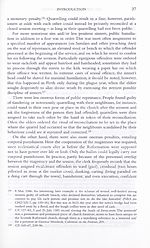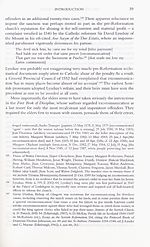Series 6 > Perth Kirk Session books, 1577-1590
(53) Page 38
Download files
Complete book:
Individual page:
Thumbnail gallery: Grid view | List view

38
THE PERTH KIRK SESSION BOOKS
that the baihes would comply.139 Warding was either in the kirk tower (for
sexual offenders), in an upper chamber of the tolbooth, or in the Spey tower.
That it was a dreadful experience is clear from complaints about the condi¬
tion of the gaols, infested with vermin.140 That there were ways of making
the ward a little less awful is suggested in the 20 November 1582 entry
about sexual offenders going to the kirk tower’s window - to talk with their
friends below, perhaps, or just to get a breath of fresh air. Only about twelve
feet square, the ‘ward of the fornicators’ in St John’s kirk would have made
cramped quarters, especially if divided into sections for men and women.
People also stored timber in the tower, as we know from the session’s peri¬
odic efforts to make them remove it; some, however, would remain in the
tower for erecting the town scaffold - a feature of the tower experience that
may have gone a long way to inspire penitence in the sinners imprisoned
there.141 The size of the Spey tower and tolbooth prisons is unknown, but
conditions there were doubtless wretched as well, as suggested by desperate
attempts to escape: in one instance, a man burned the wooden door of
the tolbooth gaol to escape, only to have a neighbour raise the hue and
cry.142 These conditions are worth remembering when reading of the elders’
frequent consignment of sinners to ward. A sentence to the crosshead was
added to warding for the most audacious sinners, like Barbara Brown, who
foohshly boasted of her acts of fornication while sitting on the stool of
repentance in the church on a Sunday.143
The most serious spiritual penalty was excommunication. What is striking
from these minutes is how seldom it was threatened, let alone imposed. The
elders ordered excommunication in only six cases during the fourteen-year
period of this volume.144 They threatened to excommunicate recalcitrant
139 There are few instances of non-compliant bailies: e.g., NRS ms CH2/521/6, fo. 58v., and
in this volume, 29 Jan. 1582 (the bailies ‘altogether slothful and negligent’) and 30 Aug.
1585 (bailies threatened with excommunication for their neghgence).
CH2/521/8/1, fo. 99v.
141 CH2/521/1, 29 Jan. 1583; Book of Perth, 59.
142 PKCA ms B59/12/9, fo. 74 (9 Feb. 1583). The prisoner, a debtor named Peter Camsay,
let the fire die down and then ‘thrusted himself forth thereout of’, but ‘perceiving [Jonet
Lutfute, a jeweller’s wife] spying him eschewing himself forth of ward, most cruelly and
unnaturally struck her with his whinger on divers parts of her heel to the effusion of
her blood in great abundance, and . . . cast her down the said tolbooth stair [suggesting
that the ward was in an upper chamber] through the which her haill bones of her body
are broken, upon which she and her husband sued Camsay for damages. The council in
1604 admitted the ‘insufficiency of the ward’ as a cause of‘skaith and danger’: PKCA ms
B59/16/1, fo. 90r. NRS ms CH2/521/3, p. 55, notes another escape (1598).
143 26 July 1585.
144 Elspeth Carvor (adultery, 31 Mar., 14 Apr., and 27 May 1578; 29 Jan. [the excommunica¬
tion date] and 20 July 1579; cf. 18 June 1585, when her husband questioned if her last
child were his); Margaret Ruthven (adultery, 14 Apr., 18, 21, and 28 Aug., 9 and 19 Oct.
1578; 11 [the excommunication date] and 18 May 1579, 5 Sept. 1580; cf. 8 Aug. 1587 - a
THE PERTH KIRK SESSION BOOKS
that the baihes would comply.139 Warding was either in the kirk tower (for
sexual offenders), in an upper chamber of the tolbooth, or in the Spey tower.
That it was a dreadful experience is clear from complaints about the condi¬
tion of the gaols, infested with vermin.140 That there were ways of making
the ward a little less awful is suggested in the 20 November 1582 entry
about sexual offenders going to the kirk tower’s window - to talk with their
friends below, perhaps, or just to get a breath of fresh air. Only about twelve
feet square, the ‘ward of the fornicators’ in St John’s kirk would have made
cramped quarters, especially if divided into sections for men and women.
People also stored timber in the tower, as we know from the session’s peri¬
odic efforts to make them remove it; some, however, would remain in the
tower for erecting the town scaffold - a feature of the tower experience that
may have gone a long way to inspire penitence in the sinners imprisoned
there.141 The size of the Spey tower and tolbooth prisons is unknown, but
conditions there were doubtless wretched as well, as suggested by desperate
attempts to escape: in one instance, a man burned the wooden door of
the tolbooth gaol to escape, only to have a neighbour raise the hue and
cry.142 These conditions are worth remembering when reading of the elders’
frequent consignment of sinners to ward. A sentence to the crosshead was
added to warding for the most audacious sinners, like Barbara Brown, who
foohshly boasted of her acts of fornication while sitting on the stool of
repentance in the church on a Sunday.143
The most serious spiritual penalty was excommunication. What is striking
from these minutes is how seldom it was threatened, let alone imposed. The
elders ordered excommunication in only six cases during the fourteen-year
period of this volume.144 They threatened to excommunicate recalcitrant
139 There are few instances of non-compliant bailies: e.g., NRS ms CH2/521/6, fo. 58v., and
in this volume, 29 Jan. 1582 (the bailies ‘altogether slothful and negligent’) and 30 Aug.
1585 (bailies threatened with excommunication for their neghgence).
CH2/521/8/1, fo. 99v.
141 CH2/521/1, 29 Jan. 1583; Book of Perth, 59.
142 PKCA ms B59/12/9, fo. 74 (9 Feb. 1583). The prisoner, a debtor named Peter Camsay,
let the fire die down and then ‘thrusted himself forth thereout of’, but ‘perceiving [Jonet
Lutfute, a jeweller’s wife] spying him eschewing himself forth of ward, most cruelly and
unnaturally struck her with his whinger on divers parts of her heel to the effusion of
her blood in great abundance, and . . . cast her down the said tolbooth stair [suggesting
that the ward was in an upper chamber] through the which her haill bones of her body
are broken, upon which she and her husband sued Camsay for damages. The council in
1604 admitted the ‘insufficiency of the ward’ as a cause of‘skaith and danger’: PKCA ms
B59/16/1, fo. 90r. NRS ms CH2/521/3, p. 55, notes another escape (1598).
143 26 July 1585.
144 Elspeth Carvor (adultery, 31 Mar., 14 Apr., and 27 May 1578; 29 Jan. [the excommunica¬
tion date] and 20 July 1579; cf. 18 June 1585, when her husband questioned if her last
child were his); Margaret Ruthven (adultery, 14 Apr., 18, 21, and 28 Aug., 9 and 19 Oct.
1578; 11 [the excommunication date] and 18 May 1579, 5 Sept. 1580; cf. 8 Aug. 1587 - a
Set display mode to:
![]() Universal Viewer |
Universal Viewer | ![]() Mirador |
Large image | Transcription
Mirador |
Large image | Transcription
Images and transcriptions on this page, including medium image downloads, may be used under the Creative Commons Attribution 4.0 International Licence unless otherwise stated. ![]()
| Scottish History Society volumes > Series 6 > Perth Kirk Session books, 1577-1590 > (53) Page 38 |
|---|
| Permanent URL | https://digital.nls.uk/127281273 |
|---|
| Description | Over 180 volumes, published by the Scottish History Society, containing original sources on Scotland's history and people. With a wide range of subjects, the books collectively cover all periods from the 12th to 20th centuries, and reflect changing trends in Scottish history. Sources are accompanied by scholarly interpretation, references and bibliographies. Volumes are usually published annually, and more digitised volumes will be added as they become available. |
|---|


